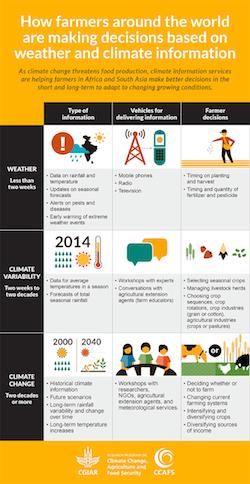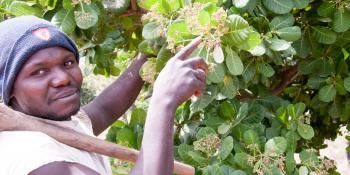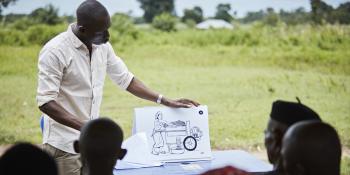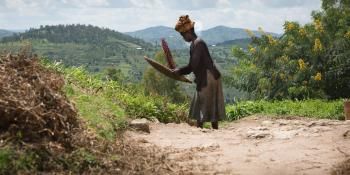As climate change threatens food production, countries fight back by arming farmers with precise advice on growing conditions

JOHANNESBURG, SOUTH AFRICA (4 November 2014)—With weather extremes caused by climate change now widely seen as a major threat to food production in Africa and South Asia, a new report finds that many countries are already providing millions of farmers with innovative “climate information services” that allow them to anticipate and adapt to rapidly changing conditions.
Countries are mobilizing community radio stations, government meteorological services, religious groups, agriculture extension agents, schools and farmers themselves to develop and distribute forecasts and farming strategies that provide a front-line defense against the effects of climate change on food production, according to the study by the CGIAR Research Program on Climate Change, Agriculture and Food Security (CCAFS).
The report, Scaling up climate services for farmers: Mission Possible, is the first analysis of this new approach to adapting to the stresses of climate change. It comes as experts prepare for a major conference, Managing Agricultural Risks in a Changing Climate in Sub-Saharan Africa, to be held November 4-5 in Johannesburg, South Africa. The conference, hosted by the Forum for Agricultural Risk Management in Development (FARMD), is expected to attract 200 participants from the public and private sector to focus on practical solutions to managing short-term climate risks while building resilience over the long term.
“It’s encouraging to see climate information services emerging that are drawing from many types of experts and engaging a wide range of partners to devise effective strategies to help farmers cope with a changing climate,” said Dr. Arame Tall, CCAFS’ climate services scientist and lead author of the report. “They are allowing farmers to protect themselves from the effects of weather extremes, such as droughts and floods, and also helping them take advantage of especially good conditions.”
The CCAFS report features 18 cases studies from Africa and South Asia. It finds that countries are taking a variety of approaches to climate services, which generally involve developing high-quality, location-specific data on temperature, rainfall, wind, soil moisture and ocean conditions, among other things, that help farmers decide the best crop variety to cultivate and when to plant and apply fertilizer.
The analysis reveals that the services work best when they involve broad collaborations between, for example, meteorologists, agricultural experts, farmers and agriculture extension agents. In many of the programs, farmers practice a kind of citizen science, using rain gauges to collect data on precipitation and then feeding it into centralized data repositories.
“The involvement of farmers in developing these climate services is essential to their success,” Tall said.
Prior to the advent of climate services, farmers in most developing countries had been going it alone. And while indigenous knowledge often proves accurate, the shifts in growing conditions caused by climate change are increasingly moving beyond anything many farmers or their ancestors ever experienced.
“The increasing vulnerability of smallholder farmers to climate risk is a major motivation for much of the recent interest and investment in climate services—not only to help farmers plan for tomorrow or the upcoming season, but to help them be better prepared for climate change 10, 20, or 30 years from now,” said Dr. James Hansen, a report co-author who leads the CCAFS Climate Risk Management research team.
 The study found that it’s best to combine conventional data with knowledge of local conditions to develop accurate and informative advice on farm management. It also highlighted the importance of convening national consultation workshops that can bring together climate forecasters, national policymakers and farmers to build a framework for supporting climate service production and delivery.
The study found that it’s best to combine conventional data with knowledge of local conditions to develop accurate and informative advice on farm management. It also highlighted the importance of convening national consultation workshops that can bring together climate forecasters, national policymakers and farmers to build a framework for supporting climate service production and delivery.
Furthermore, the study found that the services worked especially well when farmers could interact with other experts face to face. But services also were effective when employed by radio and other technologies that could expand their reach. For example:
- In Senegal's Kaffrine District, farmer demand for climate predictions has fueled the rapid rise of an integrated national/local climate forecasting program. Beginning with just 33 farmers in six villages in 2011, today up to 5,000 farmers are being trained to use seasonal, daily and hourly climate forecasts, and an association of 73 community-based radio stations is expected to reach more than 2 million farmers with the service.
- Thousands of farmers in 700 villages across Mali are taking part in a nationally coordinated climate service developed to help farmers cope with drought. A unique partnership between the government's meteorological service, the Ministry of Agriculture, television and radio broadcasters and farmers themselves underpin the program’s success.
- A new climate information service in Nyangi, Kenya, has enabled farmers to harvest three to four times as much maize and sorghum as in the past, which they attributed to the weather forecasts and advisories received from East Africa's Intergovernmental Authority on Development (IGAD) Climate Prediction and Applications Center (ICPAC). The information helps farmers know when they should plant, when to apply fertilizer and which seeds to sow.
- Rural farmers in six districts in Uganda are receiving seasonal climate forecasts in local languages. In some areas, children learn how to use climate information through planting orange-fleshed sweet potatoes at school, and receive climate alerts at school to take home to their families. Forecasts are also distributed through village banks, faith-based organizations, women's savings groups and farming groups.
- The Ethiopian government trained 30 agricultural development agents (DAs) in each of the country's 10 regions in how to use weather and climate information provided by the National Meteorological Agency (NMA). These DAs then train others, who in turn train farmers. The program has reached 1700 participants, 780 of which are farmers. The project produces 10-day weather forecasts and distributes them via SMS.
- As the rainy season approached in 2012, indigenous weather forecasting groups in Tanzania's Lushoto District came up with the same seasonal rain prediction as did the Tanzania Meteorological Agency. The climate services program found that farmers’ trust and willingness to pay for scientific forecasts is increased when local, traditional methods of forecasting are combined with modern scientific methods.
- A climate services pilot project has been expanded to reach up to 500,000 smallholder farmers in Kenya's Makuene County using a "training of trainers" model. It is teaching agricultural extension workers and radio broadcasters climate forecasting, enabling them to serve as the missing link between climate service providers and farmers. The program found that farmers trained in using the advisories benefited through more efficient input use and improved yields.
- Community Knowledge Workers (CKWs) in Uganda's Kasese District use low-priced smart phones loaded with a locally developed agricultural app to provide farmers with SMS messages related to regional weather, water harvesting techniques, crops, livestock, and market prices. CKWs are paid based on how many queries they answer, enabling them to make a living from brokering information services for farmers.
“Climate information services are a critical tool, offering farmers a pathway to thrive in the face of climate risk,” said CCAFS East Africa Regional Program Leader James Kinyangi, co-author. “Tailored information can protect farmers against extreme weather events that erode livelihoods, and help them to make decisions about choices and changing practices that take better advantage of productivity-enhancing technologies when climate conditions permit."
The CGIAR Research Program on Climate Change, Agriculture and Food Security (CCAFS) is a strategic partnership of CGIAR and Future Earth, led by the International Center for Tropical Agriculture (CIAT). CCAFS brings together the world’s best researchers in agricultural science, development research, climate science and earth system science, to identify and address the most important interactions, synergies and trade-offs between climate change, agriculture and food security. www.ccafs.cgiar.org


